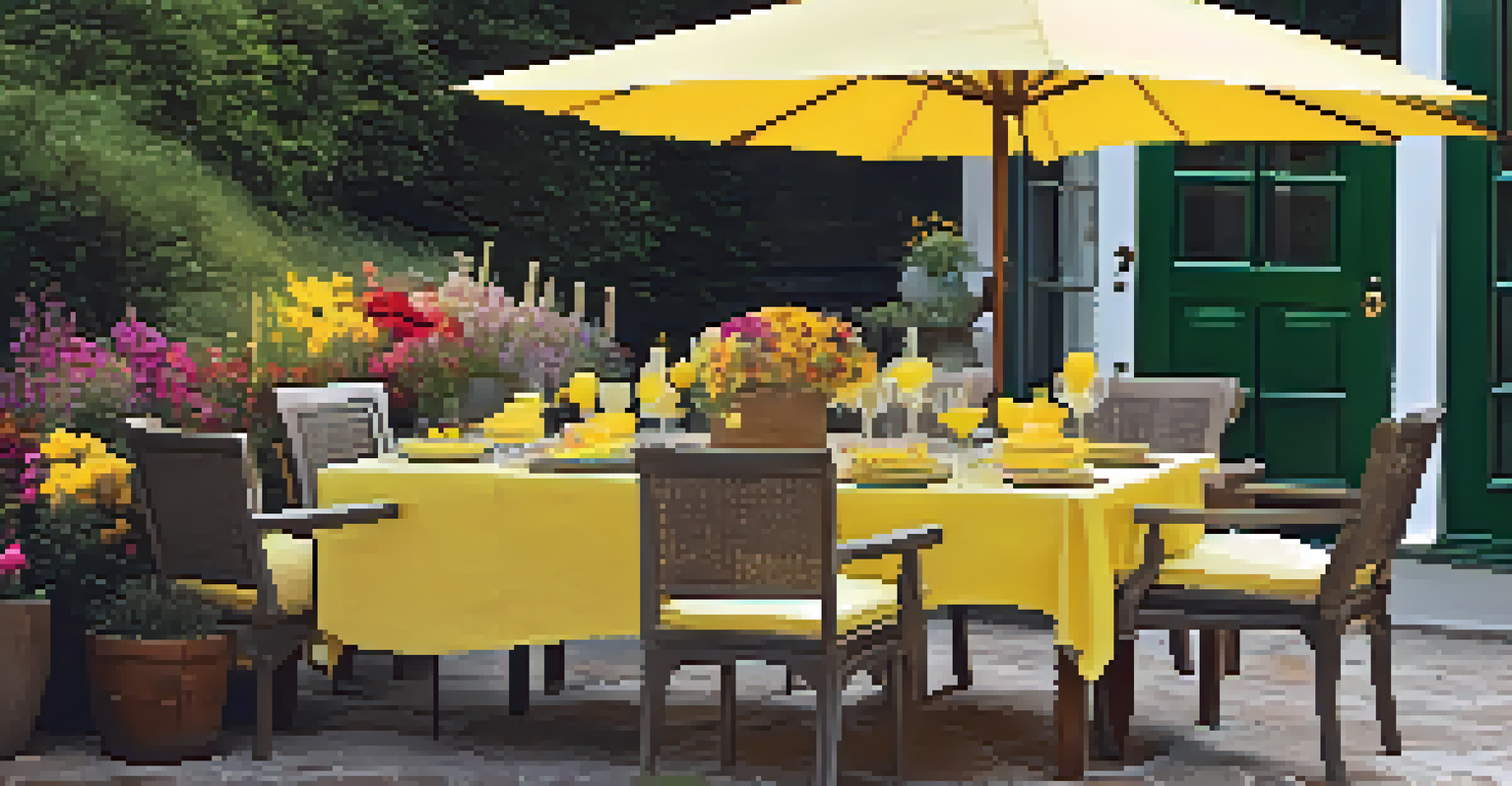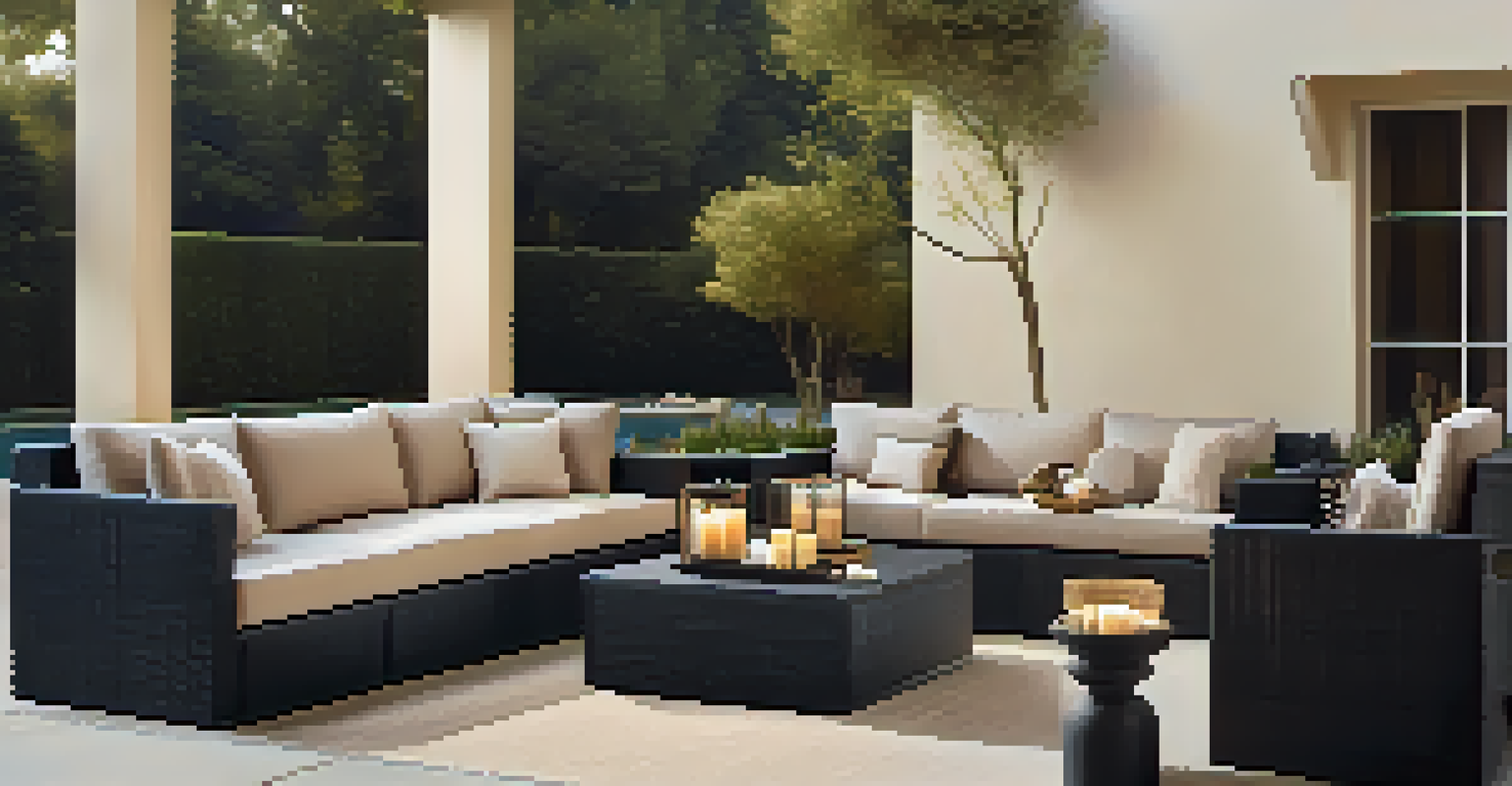The Role of Color in Outdoor Living Space Design

Understanding the Psychology of Color in Design
Color isn't just about aesthetics; it significantly affects our emotions and perceptions. Each color evokes different feelings, which can shape how we experience our outdoor spaces. For instance, blue often brings a sense of calm and tranquility, making it perfect for a relaxation area.
Color is the keyboard, the eyes are the harmonies, the soul is the piano with many strings.
When designing outdoor living spaces, it's essential to consider the psychological impact of color choices. Warm colors like red and orange can energize and invigorate, while cooler shades tend to soothe and relax. Understanding these nuances helps create the desired atmosphere in your outdoor retreat.
By aligning your color palette with the intended use of the space, you can enhance the overall experience. For example, using vibrant colors in a family area can foster energy and playfulness, while softer tones in a dining space can promote relaxation and intimacy.
Choosing a Color Palette That Reflects Your Style
Your outdoor space should feel like an extension of your home, showcasing your personal style. Selecting a color palette that reflects your taste can transform a bland area into a vibrant oasis. Think about what colors resonate with you and how they can be integrated into your outdoor design.

Consider using a cohesive color scheme that ties different elements together, such as furniture, plants, and decor. For example, if you love earthy tones, incorporating greens, browns, and warm neutrals can create a harmonious and inviting environment. This approach not only adds beauty but also creates a sense of unity in your space.
Color Influences Outdoor Atmosphere
The choice of colors in outdoor design can evoke specific emotions, enhancing relaxation or energy levels based on the palette used.
Additionally, don’t hesitate to mix and match shades within your chosen palette. Layering different hues can add depth and interest to your outdoor area, making it visually stunning. Just remember to maintain balance, so the overall look feels intentional and pleasing.
The Importance of Seasonal Considerations in Color Selection
When designing outdoor spaces, it's crucial to consider how colors will appear throughout different seasons. What looks vibrant in summer may feel dull in winter. Therefore, choosing colors that complement seasonal changes can keep your space looking fresh year-round.
Nature always wears the colors of the spirit.
For example, incorporating warm, rich colors like deep reds and oranges can evoke the feeling of autumn, while bright pastels might shine in spring. By thoughtfully selecting colors that resonate with each season, you can enhance the beauty of your outdoor living space all year long.
Moreover, pay attention to how natural light affects your color choices. Sunlight can alter how colors appear, so testing samples in different lighting conditions is a smart approach. This way, you'll ensure your outdoor space looks just as stunning in the morning light as it does in the evening glow.
Enhancing Outdoor Spaces with Colorful Accessories
If you're hesitant to commit to a full color overhaul, consider using accessories to introduce color into your outdoor space. Items such as cushions, throws, and rugs can bring pops of color without overwhelming the overall design. This approach allows for easy updates as trends or preferences change.
For instance, adding brightly colored cushions to neutral patio furniture can immediately uplift the space, making it feel more inviting. Similarly, vibrant planters or outdoor artwork can serve as focal points, drawing the eye and creating interest.
Seasonal Colors Keep Spaces Fresh
Selecting colors that complement seasonal changes ensures your outdoor living space remains vibrant and appealing throughout the year.
The beauty of accessories is their versatility; they can be swapped out seasonally or as your taste evolves. This flexibility not only keeps your outdoor living area looking fresh but also allows you to experiment with different color combinations without a significant investment.
Creating Contrast for Visual Interest in Outdoor Design
Contrast plays a vital role in outdoor design, making spaces more dynamic and visually appealing. By pairing light and dark colors, or mixing warm and cool tones, you can create a striking balance that draws attention. For example, a dark wooden deck can be beautifully complemented by light-colored furniture.
Incorporating contrasting colors can also help define different areas within your outdoor space. Using a vibrant color for a dining area can set it apart from a more subdued lounge area, making each zone feel distinct yet cohesive. This strategic use of contrast enhances functionality and encourages exploration.
Furthermore, consider the impact of contrasting textures alongside colors. A mix of smooth, glossy finishes with rough, natural materials can add depth to your design. This layered approach not only captivates the eye but also enriches the overall sensory experience of your outdoor living area.
Natural Elements: Bringing the Outdoors into Your Color Choices
When designing outdoor spaces, nature should be your greatest inspiration. The colors found in flowers, trees, and landscapes can guide your palette, creating a harmonious connection between your space and the environment. For instance, choosing colors that mimic the hues of surrounding plants can help your design blend seamlessly with nature.
Incorporating earthy tones like greens, browns, and soft yellows can evoke a sense of tranquility and connection to the outdoors. These colors not only enhance the natural beauty of your space but also promote relaxation and peace. Imagine sitting on a patio surrounded by lush greenery and soft, earthy colors—it's a perfect retreat.
Accessories Add Color Flexibly
Using colorful accessories allows for easy updates and experimentation in your outdoor space without committing to a full redesign.
Additionally, don’t forget to consider the changing colors of nature throughout the seasons. Designing with these transitions in mind can create a dynamic and ever-evolving outdoor space. By embracing the colors of nature, you can ensure your outdoor living area feels vibrant and alive, no matter the time of year.
Sustainable Color Choices: Eco-Friendly Options for Outdoor Design
In today's design landscape, sustainability is a crucial consideration, even when it comes to color choices. Opting for eco-friendly materials and paints can significantly reduce your environmental impact while still achieving stunning results. Many brands now offer low-VOC (volatile organic compounds) paints that are better for both your health and the planet.
Choosing natural materials, like wood and stone, not only brings beautiful colors into your design but also supports sustainable practices. These materials often have a timeless quality, ensuring your outdoor space remains stylish for years to come. Plus, they can be easily integrated with other colors and textures, enhancing the overall aesthetic.

By being mindful of your color choices and opting for sustainable options, you can create an outdoor living space that reflects your values. This eco-conscious approach not only benefits the environment but also resonates with those who appreciate thoughtful, responsible design.